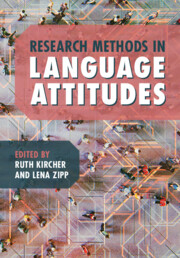Book contents
- Research Methods in Language Attitudes
- Research Methods in Language Attitudes
- Copyright page
- Contents
- Figures
- Tables
- Contributors
- Foreword
- Acknowledgements
- 1 An Introduction to Language Attitudes Research
- Part 1 Analysis of the Societal Treatment of Language
- Part 2 Direct Methods of Attitude Elicitation
- Part 3 Indirect Methods of Attitude Elicitation
- 12 The Matched-Guise Technique
- 13 The Verbal-Guise Technique
- 14 The Theatre-Audience Method
- 15 Experimental Methods to Elicit Language Attitudes among Children
- 16 The Implicit Association Test Paradigm
- Part 4 Overarching Issues in Language Attitudes Research
- References
- Index
- References
14 - The Theatre-Audience Method
from Part 3 - Indirect Methods of Attitude Elicitation
Published online by Cambridge University Press: 25 June 2022
- Research Methods in Language Attitudes
- Research Methods in Language Attitudes
- Copyright page
- Contents
- Figures
- Tables
- Contributors
- Foreword
- Acknowledgements
- 1 An Introduction to Language Attitudes Research
- Part 1 Analysis of the Societal Treatment of Language
- Part 2 Direct Methods of Attitude Elicitation
- Part 3 Indirect Methods of Attitude Elicitation
- 12 The Matched-Guise Technique
- 13 The Verbal-Guise Technique
- 14 The Theatre-Audience Method
- 15 Experimental Methods to Elicit Language Attitudes among Children
- 16 The Implicit Association Test Paradigm
- Part 4 Overarching Issues in Language Attitudes Research
- References
- Index
- References
Summary
The theatre-audience method is an indirect approach to ‘measuring’ implicit language attitudes by means of a social-psychological experiment, designed in an attempt to escape the ‘artificial’ laboratory-like contexts of the typical matched- and verbal-guise studies. The method works as follows: Over a number of evenings, an invitation to answer a questionnaire is given in different languages or varieties over the loudspeaker system in a theatre, and the varying level of cooperation is measured as the ratio of answered questionnaires to sold tickets – and interpreted in terms of variation in attitudes towards the languages or varieties used in the loudspeaker announcements. This chapter discusses the strengths of this method (e.g. data collection in a ‘natural’ context) and its limitations (e.g. the fact that people in the audience are not the same from evening to evening), and it explains the key practical issues of planning and research design (e.g. considerations regarding the choice of weekdays in order to secure comparability across evenings). Moreover, the chapter explains how to conduct statistical analyses of the data. A case study of attitudes towards varieties of Danish illustrates the main points made in the chapter.
Keywords
Information
- Type
- Chapter
- Information
- Research Methods in Language Attitudes , pp. 219 - 233Publisher: Cambridge University PressPrint publication year: 2022
References
Suggested further readings
Accessibility standard: Unknown
Why this information is here
This section outlines the accessibility features of this content - including support for screen readers, full keyboard navigation and high-contrast display options. This may not be relevant for you.Accessibility Information
- 4
- Cited by
